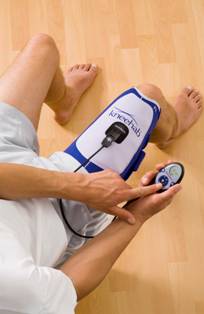Garment-based electrotherapy system for recovery from knee conditions
17 December 2009
Mobilis Rolyan has launched in the UK a garment-based EMS (electrical muscle stimulation) system, the Kneehab, which is designed to treat thigh muscle wastage, or quadriceps atrophy.
Designed to accelerate rehabilitation for those recovering from serious knee conditions, including anterior cruciate ligament reconstruction, knee replacement surgery, ligament damage, arthritis and general muscle weakness, the Kneehab works by re-educating and strengthening the quadriceps muscle through programmable cycles of contraction and relaxation.
 The
system’s neoprene thigh wrap, dual-channel controller and
anatomically-shaped electrodes were designed by the market leader in
home-based electrotherapy technology, Neurotech, in association with the
University College of Dublin’s School of Physiotherapy.
The
system’s neoprene thigh wrap, dual-channel controller and
anatomically-shaped electrodes were designed by the market leader in
home-based electrotherapy technology, Neurotech, in association with the
University College of Dublin’s School of Physiotherapy.
Kneehab is now available for direct purchase or monthly hire by physiotherapists, orthopaedic consultants, sports clubs and patients from Mobilis Rolyan, formed by the recent merger of Mobilis Healthcare into the Homecraft Rolyan business, through its customer services desk, trade catalogue and online shopping arm.
The velcro-attached thigh wrap is supplied for either the right or left leg and reutilisation for other patients and injuries is facilitated by replacement garments and gel-based electrodes, whilst retaining the main digital EMS controller, rechargeable batteries and charger.
Unlike small, hand-held EMS units, which make it difficult for patients to locate the electrodes accurately and stimulate the large thigh muscle properly, the Kneehab comprises a pad-carrier garment with electrode positioning indicators for exact pad placement, ensuring optimum performance, maximum compliance and error-free home therapy.
Large, anatomically-shaped electrode pads help to stimulate the thigh muscles effectively, ensuring even load dispersion, with one pad dedicated to the knee-stabilising VMO muscle and the remaining three to the bulk quadriceps.
Kneehab’s patented Multipath technology, developed by Neurotech, enables it to deliver highly focused and accurately coordinated contractions to the VMO and bulk quadriceps, allowing an optimal muscle fibre recruitment sequence and delivering stronger, yet comfortable contractions.
The control unit has an LCD display that gives access to three programs for a choice of rehabilitation parameters; while at the touch of a button, the clinician is able to monitor compliance between visits. Kneehab also monitors the quality of the electrical circuit and automatically pauses the unit, if contact with the skin is impaired.
The efficacy of the system has been verified in a series of clinical tests. In one study of its effectiveness after ACL reconstruction, it was found that the Kneehab group demonstrated a clear advantage at the 6 week post-operative follow up, compared with the standard rehabilitation groups. In another analysis of patients undergoing total knee arthroplasty, Kneehab users recorded significant improvements in pre-operative functional ability and quadriceps strength within 8 weeks, coupled with a 99.5% patient compliance rate.
User testimonials come from Blackburn Rovers and former Manchester United chartered physiotherapist, David Fevre, who regards Kneehab as a valuable tool for keeping football players’ ‘injury time out’ to a minimum; from Preston North End and ex-Liverpool FC professional footballer, Neil Mellor, who says he benefited greatly from using Kneehab as an aid to returning to full fitness, after several knee operations; and Irish Olympic athlete, Eileen O’Keefe, who sustained a serious knee injury and recommends Kneehab for accelerated post-operative rehabilitation.
Utilised both pre- and post-operatively to limit muscle wastage and speed recovery, Kneehab is typically used for two 20-minute sessions per day, for around 8-12 weeks, and is also recommended for younger arthritis sufferers, to keep them mobile and maintain muscle function.